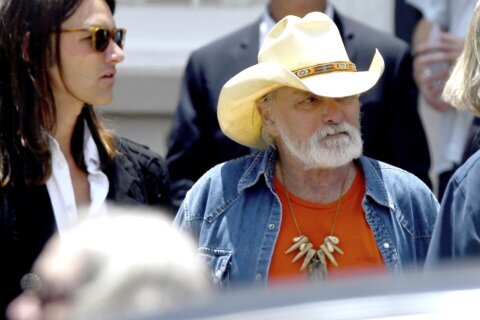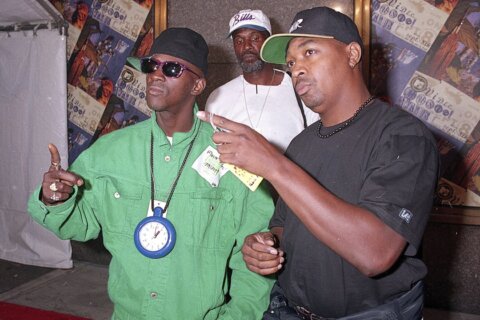Click here to listen to the full podcast breaking down Spielberg’s entire career.
Steven Spielberg’s semi-autobiographical film “The Fabelmans” opens nationwide on Wednesday, following a young boy in post-World War II America who aspires to become a filmmaker, only to discover a family secret that he can only process through cinema.
It’s time to break down the entire filmography of Hollywood’s most famous filmmaker, and to do it, WTOP Film Critic Jason Fraley invited two of the most legendary names in the history of D.C. movie reviews — longtime Channel 4 movie critic Arch Campbell and L.A.-based Observer film critic Oliver Jones, son the late Davey Marlin-Jones of Channel 9.
“This film was very moving on several levels, but for me the most profound aspect is that the urtext or even the text of Spielberg’s movies has been divorce,” Jones told WTOP. “He’s trying to understand something that’s haunted him his whole life. … Anyone who has had Spielberg’s movies play as a leitmotif through their lives will find this very moving.”
After his TV movie “Duel” (1971) and his feature film debut “The Sugarland Express” (1974), Spielberg’s first movie masterpiece was “Jaws” (1975), popularizing the summer blockbuster and remaining one of the Top 10 grossing films ever (adjusted for inflation).
“I’m thinking it was at the Uptown Theater and that’s when the newspapers first took note of the lines, people would line up around the block, thus the name blockbuster,” Campbell said. “The other thing I really remember about ‘Jaws’ is that in Spielberg movies, the music is always a character of the movie. In ‘Jaws,’ the ‘dah-duh,’ that music is a character.”
His next masterpiece was the sci-fi flick “Close Encounters of the Third Kind” (1977) as Richard Dreyfuss built mashed-potato mountains shaped like Devil’s Tower where an alien spaceship ultimately descended to communicate with John Williams’ five-note score.
“The face of that kid in that movie became the primordial mass from which all of those shots came afterward,” said Jones. “I have a theory that when directors had actors in their films repeatedly, one was who they were and one was who they wanted to be. I’ve always thought Richard Dreyfuss was who he was and Harrison Ford was who he wanted to be.”
Of course, Ford starred in Spielberg’s classic “Raiders of the Lost Ark” (1981) as Indiana Jones, who was voted the No. 2 Movie Hero of All Time by the American Film Institute. It launched an ’80s trilogy of “The Temple of Doom” (1984) and “The Last Crusade” (1989).
“I was at [KB Cinema] for opening night of ‘Raiders of the Lost Ark,'” said Campbell. “The movie starts with that scene with the boulder. As the boulder is rolling after Harrison Ford, the audience just went berserk. People were just giddy. I can’t begin to tell you the sound.”
Spielberg followed that up with “E.T. the Extra-Terrestrial” (1982), the most immortal children’s movie ever made, the fourth highest-grossing movie of all time (adjusted for inflation) and the poster child for the iconic moon logo of his Amblin production studio.
“That performance by Henry Thomas when E.T. dies at first and he starts crying, the way his face looks, I remember thinking, ‘Wow, that’s like a fake plastic doll inside some movie set surrounded by lights,'” Jones said. “For all of his technical magic, to be able to get that moment from any actor, forget that it was a kid … he caught lightning with that.”
Spielberg next adapted Alice Walker’s novel “The Color Purple” (1985), earning 11 Oscar nominations, including for Whoopi Goldberg’s breakthrough role, but not winning any.
“It is sentimental and somewhat stereotypical, but it paved the way for what is to come,” Campbell said, to which Jones added, “It’s interesting that he took on the Black experience and the American Holocaust of slavery before he took on Jewish identity and the Jewish Holocaust. He wanted to get toward that subject, but I don’t think he was ready yet.”
As he entered the ’90s, Spielberg introduced dinosaur CGI in “Jurassic Park” (1993), the biggest creature feature game-changer since the stop-motion of “King Kong” (1933).
“The footsteps on the ground, the water shaking, it’s almost the stuff before the CGI, and the sound, seeing that at the Uptown Theater, the audience just screaming,” Campbell said, as Jones added, “That movie was Pandora’s Box for six million terrible CGI movies. … We were fortunate that one of the first examples of big CGI was in such skilled hands.”
That same year, he finally won Best Director and Best Picture for his epic Holocaust masterpiece “Schindler’s List” (1993) with career performances by Liam Neeson and Ralph Fiennes, not to mention Ben Kingsley. It was Spielberg’s first pairing with cinematographer Janusz Kamiński, who filmed in black and white except for a child’s haunting red coat.
“You never forget it,” said Jones. “You can’t talk about Spielberg without audience manipulation, playing the audience like a fiddle. He had done that so many times to great rousing effect, but to do it in a profound moment of contemplation and loss, but still just as manipulative. … [The Oscars] wouldn’t award him until he ‘grew up’ to do his adult movie.”
Spielberg won his second Best Director Oscar for the WWII flick “Saving Private Ryan” (1998) with a harrowing D-Day opening as Tom Hanks led a band of brothers to save Matt Damon so that his mother didn’t receive folded flags from all of her dead sons. To this day, critics insist that it should have won Best Picture over “Shakespeare in Love” (1998).
“I was out there that year and people were saying, ‘How did that happen? How is it not ‘Saving Private Ryan? This is the worst mistake since ‘The Greatest Show on Earth,'” said Campbell. Jones added, “Everyone points to the backroom arm-twisting of Harvey Weinstein … but Dreamworks SKG had just started, so there was a little pushback.”
At the turn of the 21st century, Spielberg delivered the sci-fi flick “Minority Report” (2002) starring Tom Cruise in FBI’s pre-crime unit using “pre-cogs” to prevent future crimes.
“In the latter Spielberg, you have Tom Hanks and Tom Cruise being the two halves of Spielberg,” Jones said. “That movie took place in D.C. … It felt like he was going back to the multiplex and getting out of the museum. He was no longer going to make just films for the canon, he was making movies for us again, he was making Tom Cruise action sci-fi.”
He reunited with Cruise for the blockbuster “War of the Worlds” (2005) the same year as “Munich” (2005) about the infamous massacre of Israeli athletes at the 1972 Olympics.
“‘War of the Worlds’ was a movie that directly took on 9/11 … and is a terrifically under-appreciated film,” Jones said. “[‘Munich’] was a dividing point where he began a new partnership that would become one of his great partnerships with the writer Tony Kushner. I loved ‘Munich.’ … The idea of what appropriate response means on a spiritual level.”
A few years later, he directed Daniel Day-Lewis to his third Best Actor Oscar as Abraham Lincoln trying to convince Congress to pass the 13th Amendment in “Lincoln” (2012).
“I can’t think of a movie that is a better explanation of the process of lawmaking than that film,” Jones said. “Everyone remembers it as this vanity project for this triumphant performance, but it’s a movie about the sausage-making of Washington D.C. lawmaking.”
He next directed Mark Rylance to a Best Supporting Actor Oscar in “Bridge of Spies” (2015), a Cold War spy thriller starring Tom Hanks with a script by the Coen Brothers.
“It was such an introduction to Mark Rylance and I’ve been such a fan of his ever since,” Campbell said, to which Jones added, “I enjoy that movie a lot. I like Cold War films and he had a distinct Cold War period now with the idea of what war means psychologically.”
Last year, he directed Ariana DeBose to a Best Supporting Actress Oscar in the remake of the musical “West Side Story” (2021) with overhead shadows of the Sharks and the Jets.
“I think in a different time, his remake of ‘West Side Story’ would have been much bigger than it was given that it was in the middle of the pandemic when people weren’t going to theaters or were just maybe thinking about going back to theaters,” said Campbell. “I taped the [1961] classic and watched it again and actually liked Spielberg’s version a lot better.”
Either way, it’s fascinating that Spielberg is ironically becoming more of a critical darling than a commercial moviemaker these days with Oscar buzz for “The Fabelmans” (2022).
“‘Fabelmans’ has a lower per-screen average than ‘Black Panther,’ so now Spielberg is becoming the thing that he killed; he is becoming art house, he is becoming specialty cinema,” Jones said, earning a laugh from Campbell: “That’s why I love Oliver Jones, because he’ll make a joke, then suddenly he’ll say something absolutely profound.”
Click here to listen to the full podcast breaking down Spielberg’s entire career.








